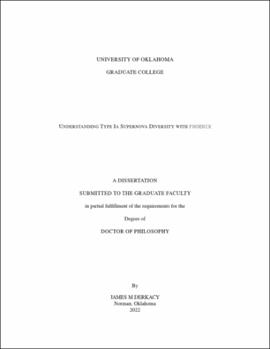| dc.description.abstract | Type Ia Supernovae (SNe Ia) are important astrophysical objects. They produce
roughly half of the iron group elements found in the universe, the energy they
release drives the evolution of galaxies, and their high
intrinsic luminosities allow them to be seen across cosmological distances.
Through the width-luminosity relation (often called the Phillips relation),
they can be used as ``standardizable candles" to serve as cosmological
distance indicators and were instrumental in the discovery of the accelerating
expansion rate of the universe. However, despite decades of detailed study,
many fundamental questions about these objects remain; including the exact
nature of their progenitor systems and the mechanism(s) by which they explode.
UV spectra are unique probe of SNe Ia physics and their evolution in throughout
the history of the universe, as much of the information about the properties of
the progenitor star and the explosion mechanism are encoded in the outer layers
of the ejecta; a region that ultraviolet spectra probe at later times than the
optical. The ultraviolet properties of SNe Ia are much more diverse than in the
optical and near infrared, and may vary with redshift. The ultraviolet
properties of SNe Ia have the ability to help us unlock their true nature; but
have historically been under-studied due to difficulties in obtaining observations
in this wavelength regime. However, recent growth in the data sets
of SNe Ia observed with the Hubble Space Telescope and the Neil Gehrels
Swift Observatory (Swift), have illuminated the need for detailed modeling
of this region in order to perform the differential comparisons necessary to
further our understanding of these objects and improve their use as cosmological
distance indicators.
In Part I, I discuss the theoretical foundations of this work. I
briefly review the important aspects of spectral formation in the ultraviolet of
SNe Ia, and introduce the two codes SYNOW and PHOENIX) used to generate
synthetic spectra of SNe Ia. I apply the spectra generated from these codes to
the UV spectra of SN~2011fe and for the first time make line identifications in
all the major ultraviolet features near maximum light, including the first ever
identifications of C IV and Si IV in a SNe Ia spectrum. Then, using
the suite of PHOENIX models, I explore the impact of luminosity variations on the
ultraviolet spectra and discuss the connections I find between the ultraviolet
and other wavelength regimes.
In Part II, I shift focus and discuss how differential comparisons in
observational studies can further our understanding of SNe Ia.
Chapter 4 details the science cases behind nearly five years of
observations using the Astrophysical Research Consortium 3.5-m telescope at Apache
Point Observatory, including highlighting instances where my observations
contributed to the advancement of our understanding of the underlying physics of
all types of supernovae and their progenitors. Chapter 5 focuses on
SN 2021fxy, a Type Ia supernovae observed extensively in multiple wavelength regimes
by the Precision Observations of Infant Supernovae (POISE) collaboration, for which
ultraviolet spectra were obtained with the Hubble Space Telescope. In
comparing SN 2021fxy to the broader sample of spectroscopically normal SNe Ia with
ultraviolet spectra from HST, I show that mid-ultraviolet flux suppression is
a common feature of SNe Ia and discuss possible mechanisms that cuase this flux
suppression and how they may be connected to different progenitors and explosion
mechanisms. Additionally, I show that SN 2021fxy is substantially similar to another
SN Ia with mid-ultraviolet suppression, SN 2017erp, and illustrate how luminosity
variations between the two SNe Ia may be responsible for the observed flux differences
between them. | en_US |
